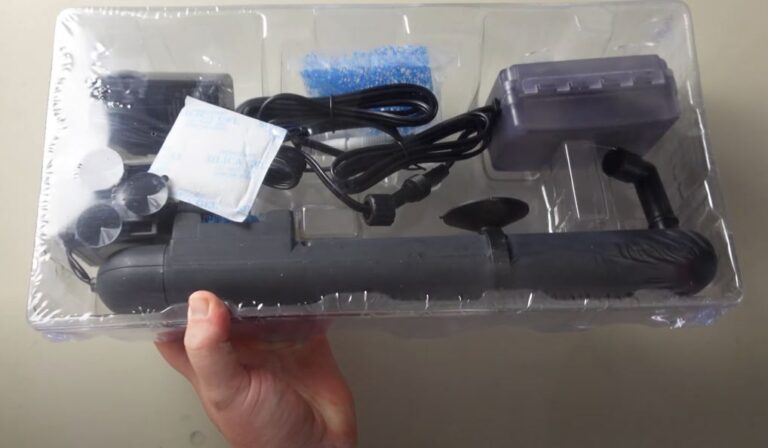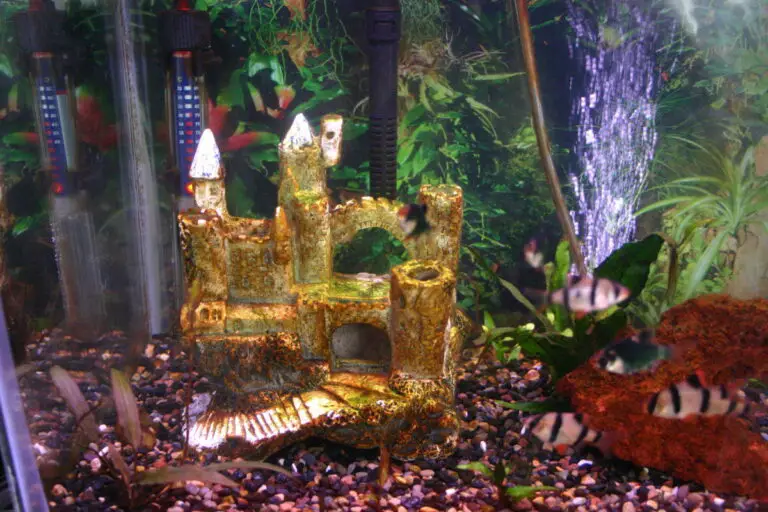How to Lower GH in Aquarium?
Lowering GH in an aquarium can be achieved by using reverse osmosis (RO) or deionized (DI) water. RO and DI filters remove the minerals from tap water, making it very soft. To use these filters you will need to purchase a filter system with a membrane element that will remove calcium and magnesium from the tap water.
You may also need to purchase additional components such as carbon pre-filters, sediment prefilters, storage tanks for filtered water and automated shut off valves or pumps depending on your setup. It is best to test the GH level of your RO/DI water before adding it to your aquarium so you know what type of adjustments are needed if any. Additionally, driftwood can help lower GH levels over time due to its ability to absorb minerals from the tank’s environment.
How to Soften Aquarium Water (Decrease Hardness)?
- Test the water for GH levels: The first step to lowering GH in an aquarium is to test the current level of general hardness (GH). This can be done using a liquid or strip test kit that measures GH, which is available from most pet stores.
- Perform a partial water change: Once you know the current level of GH in your tank, it’s time to lower it by performing a partial water change. To do this, use dechlorinated tap or filtered water and remove around 10-25% of the aquarium’s existing volume depending on how high your GH reading was initially and replace with fresh dechlorinated water.
- Add peat moss: Adding peat moss to your filter system can also help reduce overall general hardness levels as it releases tannins into the tank which reduces pH levels naturally over time while also softening hardwater due to its carbon content. Peat moss should be replaced every two weeks or so unless testing shows that more frequent changes are needed.
- Use RO filter systems: Reverse osmosis (RO) filters are designed specifically for removing minerals from tap and well water sources in order to create purer H2O for fish tanks. Making them ideal for reducing background mineral concentrations like calcium and magnesium which contribute towards higher general hardness readings
What Causes High GH in Aquarium?
High Gh in an aquarium can be caused by several factors, such as the hardness of the source water used to fill the tank, certain chemicals or supplements added to the water, and natural minerals that leach into the tank from rocks and gravel. Out of these sources, source water is generally considered to be the main cause of high Gh levels in an aquarium.
How to Naturally Lower GH in Aquarium?
Lowering GH in an aquarium can be done naturally by adding peat, driftwood and certain types of rocks. Peat helps lower pH levels while driftwood and rocks leech out minerals. Additionally, water changes help to reduce overall mineral content as well as replacing the filter media regularly.
Chemical buffers are also available which work to stabilize pH levels in the aquarium but should be used with caution as they may cause more harm than good if not monitored properly.
How to Lower GH in Freshwater Aquarium?
Lowering GH in a freshwater aquarium can be done with techniques such as water changes, using reverse osmosis filters, and adding peat moss or driftwood to the tank. Water changes are one of the easiest methods for reducing GH levels; this should be done at least once a week to remove minerals from the tank and replace them with fresh, dechlorinated water. Reverse osmosis filters are also effective for removing excess minerals from the water; these should be used in conjunction with regular water changes for maximum effectiveness.
Lastly, adding peat moss or driftwood will help reduce GH levels by releasing tannins into the aquarium which act as natural acidifiers.
How to Lower GH in Aquarium (Reddit)?
If you’re trying to lower GH in your aquarium, there are a few simple steps you can take. First, make sure that the water source is low in minerals, such as reverse osmosis or distilled water. If this isn’t an option for you, consider using a de-mineralizing filter to remove excess minerals from the tap water.
Another way to lower GH is by adding peat moss or driftwood to the tank which will slowly release tannins into the water and reduce GH levels over time. Finally, making partial water changes regularly helps balance out mineral concentrations and keep GH levels balanced.
How to Lower GH And KH in Aquarium?
Lowering GH and KH in aquarium water requires a few steps. First, remove any carbon filters or activated charcoal from the tank as these can raise the levels of GH and KH. Next, do frequent partial water changes with dechlorinated tap water to reduce the concentration of minerals in the tank.
Also, adding reverse osmosis (RO) filtered water can help lower GH and KH levels since it is free of most minerals. Finally, some aquatic plants may help reduce mineral content if they are regularly trimmed back – this will also improve oxygen circulation which is beneficial for fish health.
How to Lower GH Without Lowering KH?
Lowering the GH without lowering KH is possible by using water conditioners designed to remove dissolved minerals from water. These products work by binding the calcium, magnesium and other hard minerals in the aquarium water so they can be removed when you do a partial water change. It’s important to remember that these products won’t reduce your KH levels but will reduce your GH levels, allowing for more flexibility in maintaining your desired parameters.
Additionally, it is important to regularly monitor both your GH and KH values after using these types of products as they may need regular replenishment or adjustment depending on tank size and stocking level.
Is 180 GH Bad for Fish?
No, 180 GH (general hardness) is not bad for fish. In fact, it’s ideal for many freshwater species as it replicates their natural habitat. Hard water is beneficial because it provides essential minerals such as calcium and magnesium that fish need to stay healthy and thrive.
Does Water Conditioner Lower GH?
Yes, water conditioner can lower GH (general hardness) in your aquarium. Water conditioners usually contain chemicals that remove minerals from the water, which helps reduce GH levels. It’s important to use these products carefully as overusing them can lead to an unhealthy environment for your fish and other aquatic life.
Additionally, you may need to supplement with additional calcium or magnesium if you find that GH levels are too low after using a water conditioner product.

Credit: www.youtube.com
How Do I Reduce Gh in My Aquarium Naturally?
There are a few natural ways to reduce GH in your aquarium. The most effective and long-term solution is to change the water regularly, either with partial water changes or by using reverse osmosis (RO) filtered water. By using RO filtered water, you can drastically reduce the hardness of your aquarium water without having to do frequent and large partial water changes.
You should also check the type of substrate you’re using in your aquarium, as certain substrates – such as limestone gravel – can raise GH levels significantly over time due to their mineral content. Additionally, adding aquatic plants like Anubias or Java Ferns can help lower GH levels naturally through their filtration process; however these plants will require proper care and maintenance if they are used in this manner. Finally, if all else fails, there are commercial products available which claim to reduce GH levels quickly and effectively; though it’s recommended that you research them carefully before making any purchases so that you know exactly what chemicals they contain and how they might affect the rest of your tank inhabitants.
How Do I Lower the Hardness in My Fish Tank?
If you find that the hardness in your fish tank is too high, there are a few different things you can do to lower it. The first step is to keep up with regular water changes, as this helps to remove mineral buildup from the aquarium and reduce overall hardness levels. You should also be sure to use a good quality dechlorinator when adding new water, as this will help prevent any additional minerals from entering your tank.
Another option for lowering hardness is to add peat moss or driftwood into your tank; these items release tannins which act like a natural softener for the water. Finally, using an RO/DI filter system can be an effective way of lowering the overall hardness of your tank’s water by removing impurities and dissolved solids such as calcium carbonate. Taking these steps should help you create a healthy environment for all of your aquatic inhabitants!
Why is My Aquarium Gh So High?
Aquarium general hardness (GH) is an important water quality parameter that affects the health of aquarium inhabitants. High GH levels can cause stress and disease in fish, as well as cause cloudy water or unwanted algae growth. If your aquarium’s GH level is too high, it could be due to a number of factors such as over-filtration with hard tap water, excessive mineral supplementation from additives or salts, and natural processes like evaporation which can concentrate minerals in the remaining tank water.
Fortunately, there are some simple steps you can take to lower your aquarium’s GH levels without compromising other important parameters like pH or calcium. These include diluting your tank water with purified RO/DI filtered water; using chemical media like peat moss to soften the water; adding bottled springwater instead of tap; and performing regular partial changes with soft conditioned well-water if available. Although reducing GH may not always be necessary depending on the species kept in your tank, monitoring this parameter closely will help ensure optimal conditions for both aquatic life and plants alike!
Conclusion
Lowering GH in your aquarium is an important part of maintaining the health and well-being of your fish. By taking the time to understand how to lower GH levels, you can help ensure that every creature in your tank has a healthy environment. With pH buffers, water changes, and other strategies like using reverse osmosis filters or rainwater collection tanks, you have many options for reducing GH levels while still providing optimal care for all inhabitants of the tank.
Lowering GH can be done safely with careful monitoring and attention to detail; it’s just one way demonstrated here that will help promote a happy home for everyone living in your aquarium.





